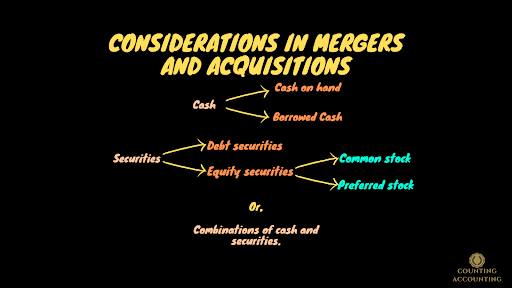If you've ever heard the term "Consideration" in the context of mergers and acquisitions, consideration is what the bidding company pays for the target company. There are several different types of considerations in a merger you could have.
Cash deal: An all-cash deal where the bidding company pays for the target either with just cash, it already has on hand or they go out and borrow money so it's debt-financed. They go and they borrow money to acquire the target company.
Securities: The merger could also be financed, where you don't have any cash at all instead, the merger could be financed with securities. So it could be debt securities or equity securities that the bidding company is paying in order to acquire this target company. Now if we're talking about equity securities could be common stock or could be preferred stock. So if you hear about a stock deal in a merger, very frequently it is common stock. The bidding company is issuing or giving away some of its common stock to acquire the target company.
Combination: You could have a combination, where there's stock in order to acquire the target company.
I'm gonna go through this in a little bit more detail particularly with the stock acquisition because this could be complicated and it gets down to whether we're gonna have a fixed or a floating exchange ratio.
Fixed Exchange Ratio:
So if you are doing a stock deal, you could offer a set number of shares to acquire the target firm. Then it's just the number of shares is set, let's say it's just 20 million that's the end of the story, so that's called a fixed exchange ratio.
Floating Exchange Ratio:
Now you say well that's pretty simple, you're just offering 20 million shares and your own company to acquire this other company but here's where it gets a little more complicated. In some cases, you have what's called a floating exchange ratio where you're not having a fixed amount of shares. You're not saying "There's gonna be 20 million shares that's what I'm gonna pay." but what you'll say is "I'm gonna pay 10 billion dollars worth of our shares." Now the question is "How do we compute what is the 10 billion dollars worth of shares?"
Value of Stock Offered:
We've got this formula here that would be useful for you but basically, we take the value of the stock being offered, well that's just a 10 billion divided by their average stock price during that time period, let's say that is 2 months.
Example:
Let's say that here our denominator was $400 a share, that's the average stock price during the pricing period. And they offered 10 billion dollars worth of their own shares. If we use our formula we get $25 million shares. So that's what they're gonna end up paying 25 million shares to acquire this target.
The Collar Concept
Now, it can get more complicated, sometimes we have a thing called a collar. The collar would be used with this floating exchange ratio. You could be worked out in the deal where we say there's gonna be a set floor or a ceiling in terms of maybe we say in no case will it be fewer than 20 million shares and in no case would it be more than 30 million shares. You'd say like it's capped between 20 and 30 like it could float between there but it's not gonna go below 20 and it's not gonna go over 30. So that would be called a collar. So you can see this you're pretty complex and this applies not just to stock deals but to all-cash, combinations. So the bidder price can be fixed or variable and the bidder offer might have a contingency.
Let's say we've got one company is company A and they want to merge with company B. And company A says "I think Company B is worth 100 million dollars." Company B says "We're worth 200 million dollars, we're not worth 100 million." and so you've got this argument between the firms over what Company B is worth. So what they could do is they get to structure the deal.
Earn-out:
In an Earn-out the basic idea will be to acquire Company B for 100 million but if B's EBIT/EPS reaches some threshold next year we'll kick in an extra 100 million. So then it will be 200 hundred million. It's kind of like "We've got a discrepancy of the price, so we'll have some base price but then if you reach a certain financial goal, we will give the seller more money to compensate for that."
Contingent value rights:
This is a similar idea of something happens but it's not necessarily a financial goal. If we're talking about maybe the target company B is a pharmaceutical company and they have some drug that could potentially be a blockbuster drug but it hasn't been approved yet. So company A the bidder says "Well, listen if that drug gets approved, if this certain event occurs then we'll kick in an extra 150 million dollars."






